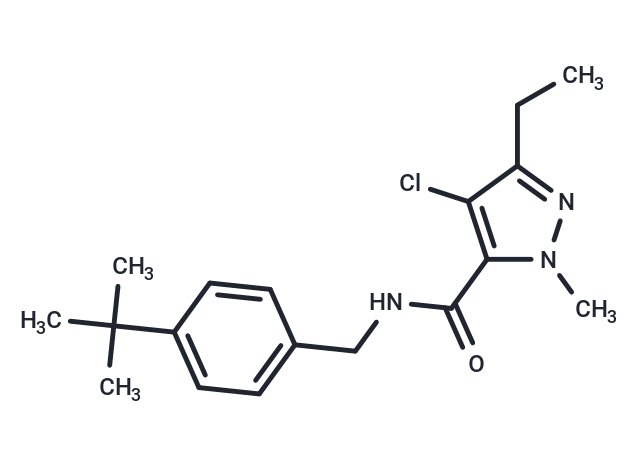Shopping Cart
- Remove All
 Your shopping cart is currently empty
Your shopping cart is currently empty

Tebufenpyrad (Comanche) (mitochondrial complex-1 inhibitors) is an agro-chemically important acaricide that functions like the known mitochondrial toxicant rotenone.

| Pack Size | Price | Availability | Quantity |
|---|---|---|---|
| 100 mg | $77 | In Stock | |
| 200 mg | $128 | In Stock | |
| 1 mL x 10 mM (in DMSO) | $45 | In Stock |
| Description | Tebufenpyrad (Comanche) (mitochondrial complex-1 inhibitors) is an agro-chemically important acaricide that functions like the known mitochondrial toxicant rotenone. |
| In vitro | Exposing rat dopaminergic neuronal cells (N27 cells) to tebufenpyrad and pyridaben for 3 h induced dose-dependent cell death with an EC50 of 3.98 μM and 3.77 μM, respectively. Also, tebufenpyrad and pyridaben (3 μM) exposure induced reactive oxygen species (ROS) generation and m-aconitase damage, suggesting that the pesticide toxicity is associated with oxidative damage. Morphometric image analysis with the MitoTracker red fluorescent probe indicated that tebufenpyrad and pyridaben, as well as rotenone, caused abnormalities in mitochondrial morphology, including reduced mitochondrial length and circularity. Functional bioenergetic experiments using the Seahorse XF96 analyzer revealed that tebufenpyrad and pyridaben very rapidly suppressed the basal mitochondrial oxygen consumption rate similar to that of rotenone. Further analysis of bioenergetic curves also revealed dose-dependent decreases in ATP-linked respiration and respiratory capacity. The luminescence-based ATP measurement further confirmed that pesticide-induced mitochondrial inhibition of respiration is accompanied by the loss of cellular ATP [1]. |
| Alias | Pyranica, MK239, Comanche |
| Molecular Weight | 333.86 |
| Formula | C18H24ClN3O |
| Cas No. | 119168-77-3 |
| Smiles | CCc1nn(C)c(C(=O)NCc2ccc(cc2)C(C)(C)C)c1Cl |
| Relative Density. | 1.13g/cm3 |
| Storage | Powder: -20°C for 3 years | In solvent: -80°C for 1 year | Shipping with blue ice. | |||||||||||||||||||||||||||||||||||
| Solubility Information | DMSO: 60 mg/mL (179.72 mM), Sonication is recommended. | |||||||||||||||||||||||||||||||||||
Solution Preparation Table | ||||||||||||||||||||||||||||||||||||
DMSO
| ||||||||||||||||||||||||||||||||||||

Copyright © 2015-2025 TargetMol Chemicals Inc. All Rights Reserved.